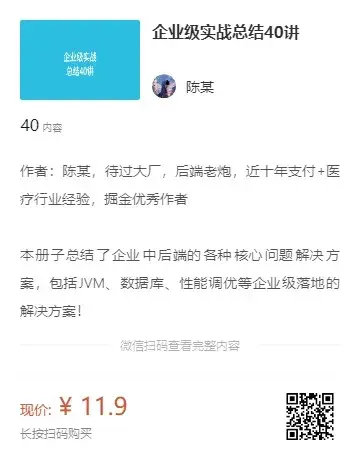在當今分佈式系統的背景下,如何優雅地實現系統之間的消息傳遞是每個開發者都關心的話題。而Spring Integration,作為Spring家族的一員,正是為了解決這個難題而生。
在這篇文章中,我們將踏上穿越消息之路,深入探討Spring Integration的魅力。
關注公眾號:碼猿技術專欄,回覆關鍵詞:1111 獲取阿里內部Java性能調優手冊!
Spring Integration基礎概念
1. 起源:
- Spring Integration是Spring框架的一個擴展,旨在簡化企業集成模式的開發。它提供了一種基於消息的編程模型,使得在分佈式系統中進行系統集成變得更加容易。
2. 基本概念:
- 消息: Spring Integration使用消息來在系統中傳遞信息。消息是信息的載體,它可以包含業務數據、頭部信息、消息標籤等。消息在系統中沿着通道(Channel)傳遞。
- 通道(Channel): 通道是消息在系統中傳遞的管道。Spring Integration提供了不同類型的通道,如直接通道(Direct Channel)、發佈-訂閲通道(Publish-Subscribe Channel)、隊列通道(Queue Channel)等。
- 端點(Endpoint): 端點是消息的生產者或者消費者。消息從一個端點流向另一個端點,形成一個消息的處理流程。
- 適配器(Adapter): 適配器用於將外部系統或者服務與Spring Integration整合。它可以將外部系統的消息轉換為Spring Integration的消息,也可以將Spring Integration的消息傳遞給外部系統。
- 過濾器(Filter): 過濾器用於過濾消息,只有滿足特定條件的消息才能通過。它可以用於消息的路由、轉換等。
- 轉換器(Transformer): 轉換器用於將消息從一種形式轉換為另一種形式,以滿足系統的需求。它可以用於數據格式的轉換、消息體的修改等。
推薦下博主的小冊子,企業級實戰總結40講
Spring Integration與傳統消息中間件的區別與聯繫:
1. 區別:
- Spring Integration是框架: Spring Integration是一個基於Spring的框架,它提供了一整套用於構建企業集成模式的工具和組件。
- 傳統消息中間件是產品: 傳統消息中間件通常是獨立的產品,如RabbitMQ、Apache Kafka、ActiveMQ等,它們專注於提供消息傳遞服務。
2. 聯繫:
- 整合性: Spring Integration可以與傳統消息中間件集成使用,通過適配器與外部消息中間件進行通信。這樣,Spring Integration可以作為一箇中間層,幫助企業集成系統與不同的消息中間件進行對接。
- 解耦與異步通信: 類似傳統消息中間件,Spring Integration也支持解耦和異步通信的模式,通過消息的發佈與訂閲,實現系統組件之間的解耦和鬆耦合。
- 消息傳遞: Spring Integration和傳統消息中間件一樣,都是基於消息傳遞的模型。消息作為信息的載體,在系統中傳遞,實現不同組件之間的通信。
總體而言,Spring Integration提供了一種更加輕量級和靈活的方式來實現企業集成,而傳統消息中間件更專注於提供可靠的消息傳遞服務。在實際應用中,可以根據具體的需求選擇合適的技術和工具。
關注公眾號:碼猿技術專欄,回覆關鍵詞:1111 獲取阿里內部Java性能調優手冊!
消息通道與消息端點
消息通道與消息端點:
定義和配置消息通道:
- 定義消息通道:
-
- 在Spring Integration中,消息通道是消息在系統中傳遞的管道。可以使用XML配置或Java代碼來定義消息通道。
- XML配置示例:
<int:channel id="myChannel"/>-
- Java配置示例:
@Bean
public MessageChannel myChannel() {
return MessageChannels.direct().get();
}1.配置消息通道的類型:
-
- Spring Integration提供了不同類型的消息通道,如直接通道(Direct Channel)、發佈-訂閲通道(Publish-Subscribe Channel)、隊列通道(Queue Channel)等。可以根據需求選擇合適的通道類型。
- XML配置示例:
<!-- 配置直接通道 -->
<int:channel id="directChannel"/>
<!-- 配置發佈-訂閲通道 -->
<int:publish-subscribe-channel id="publishSubscribeChannel"/>
<!-- 配置隊列通道 -->
<int:queue-channel id="queueChannel"/>-
- Java配置示例:
@Bean
public MessageChannel directChannel() {
return MessageChannels.direct().get();
}
@Bean
public MessageChannel publishSubscribeChannel() {
return MessageChannels.publishSubscribe().get();
}
@Bean
public MessageChannel queueChannel() {
return MessageChannels.queue().get();2.消息通道的屬性配置:
-
- 可以通過配置消息通道的一些屬性,如容量、過期時間等,以滿足具體的需求。
- XML配置示例:
<int:channel id="myChannel" capacity="10" />-
- Java配置示例:
@Bean
public MessageChannel myChannel() {
return MessageChannels.direct().capacity(10).get();
}消息端點的作用和類型:
- 作用:
-
- 消息端點是消息的生產者或者消費者,它定義了消息的處理邏輯。消息從一個端點流向另一個端點,形成一個消息的處理流程。
2.消息端點的類型:
-
- 消息生產者端點:
-
-
- 消息源(Message Source): 用於產生消息的端點,如文件輸入、JDBC查詢等。
- 通道適配器(Channel Adapter): 用於將外部系統的消息轉換為Spring Integration的消息格式。
-
-
- 消息消費者端點:
-
-
- 服務激活器(Service Activator): 用於將消息傳遞給特定的服務進行處理。
- 消息處理器(Message Handler): 用於處理消息,可以是一個Java方法、表達式、腳本等。
-
-
- 消息路由器端點:
-
-
- 分發器(Dispatcher): 用於將消息分發給不同的子通道,根據條件進行消息路由。
-
-
- 其他類型:
-
-
- 過濾器(Filter): 用於過濾消息,只有滿足特定條件的消息才能通過。
- 轉換器(Transformer): 用於將消息從一種形式轉換為另一種形式。
-
3.配置消息端點:
-
- 消息端點可以通過XML配置或Java代碼進行定義。
- XML配置示例:
<int:service-activator input-channel="myChannel" ref="myService" method="processMessage"/>-
- Java配置示例:
@ServiceActivator(inputChannel = "myChannel")
public void processMessage(Message<String> message) {
// 處理消息的邏輯
}通過合理定義和配置消息通道以及消息端點,可以構建出靈活、可擴展的消息傳遞系統,實現消息在系統中的流動和處理。
消息處理器與適配器
消息處理器與適配器在Spring Integration中的使用:
1. 消息處理器的使用方法:
消息處理器是Spring Integration中用於處理消息的組件,它可以是一個Java方法、表達式、腳本等。以下是消息處理器的使用方法:
- Java方法處理器:
@ServiceActivator(inputChannel = "inputChannel")
public void handleMessage(String message) {
// 處理消息的邏輯
System.out.println("Received Message: " + message);
}- 上述代碼中,
handleMessage方法是一個消息處理器,通過@ServiceActivator註解將其與名為inputChannel的輸入通道關聯起來。當消息被髮送到該通道時,該方法會被調用來處理消息。 - 表達式處理器:
<int:service-activator input-channel="inputChannel" expression="@myService.process(#payload)">
<int:poller fixed-rate="1000"/>
</int:service-activator>- 上述配置中,
expression屬性定義了一個表達式,指定了消息處理的邏輯。這個表達式將調用名為process的方法,#payload表示消息的載荷。
2. 適配器與外部系統集成:
適配器用於將外部系統的消息與Spring Integration進行集成,使得外部系統的消息能夠在Spring Integration中流通。以下是適配器的使用方法:
- 文件適配器:
<int-file:inbound-channel-adapter id="filesIn"
channel="inputChannel"
directory="file:${java.io.tmpdir}/input">
<int:poller fixed-rate="5000"/>
</int-file:inbound-channel-adapter>- 上述配置使用文件適配器(
<int-file:inbound-channel-adapter>)來監聽指定目錄中的文件,並將文件內容發送到名為inputChannel的通道。 - JDBC適配器:
<int-jdbc:inbound-channel-adapter id="jdbcInboundAdapter"
query="SELECT * FROM my_table"
channel="inputChannel">
<int:poller fixed-rate="10000"/>
</int-jdbc:inbound-channel-adapter>- 上述配置中,JDBC適配器(
<int-jdbc:inbound-channel-adapter>)從數據庫執行查詢,並將結果發送到inputChannel通道。 - HTTP適配器:
<int-http:inbound-channel-adapter id="httpInboundAdapter"
channel="inputChannel"
path="/receiveMessage"
request-mapper="requestMapping">
<int:poller fixed-rate="10000"/>
</int-http:inbound-channel-adapter>- 上述配置使用HTTP適配器(
<int-http:inbound-channel-adapter>)監聽指定路徑的HTTP請求,並將請求的消息發送到inputChannel通道。
以上示例展示瞭如何使用不同類型的適配器來與外部系統進行集成。適配器將外部系統的消息轉換為Spring Integration的消息,並通過通道在整個系統中傳遞。適配器的配置取決於具體的集成需求和外部系統的特性。
消息轉換與路由在Spring Integration中的應用
1. 消息的格式轉換與處理:
消息轉換是Spring Integration中常見的操作,用於將消息從一種格式或結構轉換為另一種格式或結構,以滿足系統的需求。以下是消息轉換的實際應用場景和示例:
- JSON到對象的轉換:
@Transformer(inputChannel = "jsonInputChannel", outputChannel = "objectOutputChannel")
public MyObject convertJsonToObject(String jsonString) {
// 使用Jackson庫將JSON字符串轉換為Java對象
return objectMapper.readValue(jsonString, MyObject.class);
}- 上述代碼中,
@Transformer註解表示這是一個消息轉換器,將jsonInputChannel通道的JSON消息轉換為Java對象,並將結果發送到objectOutputChannel通道。 - 對象到JSON的轉換:
@Transformer(inputChannel = "objectInputChannel", outputChannel = "jsonOutputChannel")
public String convertObjectToJson(MyObject myObject) {
// 使用Jackson庫將Java對象轉換為JSON字符串
return objectMapper.writeValueAsString(myObject);
}- 在這個例子中,消息轉換器將
objectInputChannel通道的Java對象轉換為JSON字符串,並將結果發送到jsonOutputChannel通道。
2. 路由器的作用和實際應用場景:
路由器用於根據消息的內容或特徵將消息路由到不同的通道,實現消息在系統中的分發。以下是路由器的實際應用場景和示例:
- 內容路由器:
<int:router input-channel="inputChannel" expression="payload.type">
<int:mapping value="A" channel="channelA"/>
<int:mapping value="B" channel="channelB"/>
<int:mapping value="C" channel="channelC"/>
</int:router>- 上述配置中,內容路由器(
<int:router>)根據消息的type屬性的值將消息路由到不同的通道。如果消息的type是"A",則路由到channelA;如果是"B",則路由到channelB,以此類推。 - 篩選器路由器:
<int:router input-channel="inputChannel">
<int:mapping value="payload.type == 'A'" channel="channelA"/>
<int:mapping value="payload.type == 'B'" channel="channelB"/>
<int:mapping value="payload.type == 'C'" channel="channelC"/>
</int:router>- 在這個例子中,路由器根據篩選條件將消息路由到不同的通道。只有滿足條件的消息才會被路由到相應的通道。
路由器的靈活性使得可以根據消息的內容、屬性或條件進行動態的路由,從而實現系統中不同組件的消息處理邏輯的分離。路由器的配置可以根據具體的需求進行調整,以適應不同的應用場景。
集成模式與設計模式
Spring Integration中常見的集成模式:
Spring Integration提供了許多常見的集成模式,這些模式幫助開發人員構建可靠、可擴展的消息驅動系統。以下是一些常見的集成模式:
- 消息通道(Message Channel):
-
- 定義了消息在系統中傳遞的路徑,是消息傳遞的媒介。
2.消息端點(Message Endpoint):
-
- 定義了消息的生產者或者消費者,可以是服務激活器、消息處理器等。
3.消息適配器(Message Adapter):
-
- 用於將外部系統的消息轉換為Spring Integration的消息格式,實現系統與外部系統的集成。
4.消息網關(Message Gateway):
-
- 提供了對系統的入口,允許外部系統通過網關發送消息到系統中,或者從系統中獲取消息。
5.消息轉換器(Message Transformer):
-
- 用於對消息的格式進行轉換,將消息從一種表示形式轉換為另一種,以滿足系統的需求。
6.消息過濾器(Message Filter):
-
- 用於過濾消息,只有滿足特定條件的消息才能通過,實現對消息的篩選。
7.消息路由器(Message Router):
-
- 根據消息的內容、屬性或條件將消息路由到不同的通道,實現消息的分發。
8.聚合器(Aggregator):
-
- 將多個相關的消息合併為一個消息,通常用於處理分散的消息片段。
9.分裂器(Splitter):
-
- 將一個消息拆分為多個消息,通常用於處理大塊的消息內容。
10.定時器(Timer):
-
- 定期發送消息,用於實現定時任務或者輪詢外部系統。
如何根據設計模式構建消息驅動的系統:
構建消息驅動的系統時,可以借鑑一些設計模式來提高系統的可維護性、可擴展性和可測試性。以下是一些常用的設計模式,特別是在消息驅動系統中的應用:
- 發佈-訂閲模式(Publish-Subscribe Pattern):
-
- 在消息驅動系統中,通過使用發佈-訂閲模式可以實現消息的廣播,允許多個組件訂閲並接收相同的消息。
2.觀察者模式(Observer Pattern):
-
- 觀察者模式可以用於實現消息的訂閲和通知機制,在消息產生時通知所有的觀察者。
3.策略模式(Strategy Pattern):
-
- 策略模式可用於實現靈活的消息處理策略,根據不同的需求選擇不同的消息處理算法。
4.裝飾者模式(Decorator Pattern):
-
- 裝飾者模式可用於動態地添加消息處理邏輯,如消息轉換器、消息過濾器等。
5.責任鏈模式(Chain of Responsibility Pattern):
-
- 責任鏈模式可用於實現消息處理管道,每個處理器負責處理特定類型的消息,形成一個處理鏈。
6.命令模式(Command Pattern):
-
- 命令模式可以將消息封裝為命令對象,以支持撤銷、重做等操作。
7.工廠模式(Factory Pattern):
-
- 工廠模式可用於創建消息適配器、消息處理器等組件,提供一種靈活的對象創建方式。
通過結合這些設計模式,可以更好地組織和管理消息驅動系統的代碼,使系統更易於擴展和維護。選擇適當的設計模式取決於系統的特定需求和架構。
Spring Integration中流程和通道攔截的實現方法
在Spring Integration中,可以通過攔截器(Interceptor)來對消息通道和流程進行攔截和處理。攔截器允許在消息在通道中傳遞和處理的過程中執行自定義邏輯。
1. 通道攔截:
在通道級別,可以使用通道攔截器來對消息通道的發送和接收進行攔截。
<int:channel id="myChannel">
<int:interceptors>
<int:wire-tap channel="logChannel"/>
</int:interceptors>
</int:channel>上述配置中,<int:wire-tap>是一個通道攔截器,將通道上的所有消息發送到logChannel通道,以便記錄日誌或進行其他操作。
2. 流程攔截:
在流程級別,可以使用<int:advice>和<int:expression-advice>等元素來添加攔截器。
<int:service-activator input-channel="inputChannel" output-channel="outputChannel">
<int:advice-chain>
<int:expression-advice expression="payload.toUpperCase()"/>
</int:advice-chain>
</int:service-activator>在上述配置中,<int:expression-advice>是一個流程攔截器,它使用SpEL表達式將消息內容轉換為大寫。
攔截器的應用和自定義:
1. 內置攔截器的應用:
Spring Integration提供了一些內置的攔截器,如WireTap、LoggingHandler等,用於實現常見的攔截需求。例如:
<int:channel id="inputChannel">
<int:interceptors>
<int:wire-tap channel="logChannel"/>
</int:interceptors>
</int:channel>上述配置中,使用了內置的WireTap攔截器,將通道上的所有消息發送到logChannel通道。
2. 自定義攔截器:
可以通過實現ChannelInterceptor接口或擴展ChannelInterceptorAdapter類來創建自定義的通道攔截器。同樣,通過實現Advice接口或擴展AbstractRequestHandlerAdvice類可以創建自定義的流程攔截器。
public class CustomChannelInterceptor implements ChannelInterceptor {
@Override
public Message<?> preSend(Message<?> message, MessageChannel channel) {
// 在消息發送之前執行的邏輯
return message;
}
@Override
public void afterSendCompletion(Message<?> message, MessageChannel channel, boolean sent, Exception ex) {
// 在消息發送完成後執行的邏輯
}
// 其他方法省略
}
<int:service-activator input-channel="inputChannel" output-channel="outputChannel">
<int:advice-chain>
<bean class="com.example.CustomExpressionAdvice"/>
</int:advice-chain>
</int:service-activator>上述配置中,使用了自定義的流程攔截器CustomExpressionAdvice,該類需實現Advice接口。
通過應用內置或自定義的攔截器,可以在消息處理的不同階段執行自定義的邏輯,如日誌記錄、性能監控、消息轉換等。
實戰
傳統訂單處理流程往往涉及多個手動步驟,容易導致延遲和錯誤。為了提高電商平台的運作效率,客户那邊要求我們開發一個自動化訂單處理系統,從訂單創建到支付、庫存檢查和發貨全流程自動化處理,通過消息觸發相關的業務邏輯,減少人為失誤。
1.添加依賴:
<dependency>
<groupId>org.springframework.boot</groupId>
<artifactId>spring-boot-starter-integration</artifactId>
</dependency>
<dependency>
<groupId>org.springframework.boot</groupId>
<artifactId>spring-boot-starter-web</artifactId>
</dependency>
<dependency>
<groupId>org.projectlombok</groupId>
<artifactId>lombok</artifactId>
<optional>true</optional>
</dependency>
<dependency>
<groupId>org.springframework.boot</groupId>
<artifactId>spring-boot-starter-test</artifactId>
<scope>test</scope>
</dependency>2.啓動類Application:
@SpringBootApplication
@IntegrationComponentScan
public class OrderProcessingApplication {
public static void main(String[] args) {
SpringApplication.run(OrderProcessingApplication.class, args);
}
}3.配置消息通道
/**
* 配置消息通道
*/
@Configuration
public class IntegrationConfig {
/**
* 定義訂單創建的消息通道
* @return DirectChannel 實例
*/
@Bean
public MessageChannel orderCreatedChannel() {
return new DirectChannel();
}
/**
* 定義支付處理的消息通道
* @return DirectChannel 實例
*/
@Bean
public MessageChannel paymentProcessedChannel() {
return new DirectChannel();
}
/**
* 定義庫存檢查的消息通道
* @return DirectChannel 實例
*/
@Bean
public MessageChannel inventoryCheckedChannel() {
return new DirectChannel();
}
/**
* 定義發貨調度的消息通道
* @return DirectChannel 實例
*/
@Bean
public MessageChannel shipmentScheduledChannel() {
return new DirectChannel();
}
}4.Controller
@RestController
@RequestMapping("/orders")
public class OrderController {
private final OrderService orderService;
@Autowired
public OrderController(OrderService orderService) {
this.orderService = orderService;
}
/**
* 創建訂單的API端點
* @param order 訂單對象
* @return 成功消息
*/
@PostMapping
public String createOrder(@RequestBody Order order) {
orderService.createOrder(order);
return"Order created successfully";
}
}5.訂單服務
/**
* 訂單服務類,負責創建訂單並將訂單信息發送到相應的消息通道
*/
@Service
public class OrderService {
private final OrderGateway gateway;
@Autowired
public OrderService(OrderGateway gateway) {
this.gateway = gateway;
}
/**
* 創建訂單並觸發訂單創建流程
* @param order 訂單對象
*/
public void createOrder(Order order) {
System.out.println("Creating order: " + order.getOrderId());
// 將訂單發送到orderCreatedChannel消息通道
gateway.processOrder(order);
}
}6.支付處理服務
/**
* 支付處理服務類,監聽訂單創建消息通道,處理支付邏輯
*/
@Component
public class PaymentService {
private final OrderGateway gateway;
@Autowired
public PaymentService(OrderGateway gateway) {
this.gateway = gateway;
}
/**
* 處理訂單創建消息,模擬支付處理
* @param order 訂單對象
*/
@ServiceActivator(inputChannel = "orderCreatedChannel")
public void handleOrderCreation(@Payload Order order) {
System.out.println("Handling order creation for: " + order.getOrderId());
// 模擬支付處理
System.out.println("Processing payment for order: " + order.getOrderId());
// 假設支付成功
gateway.processPayment(order);
}
}7.庫存檢查服務
/**
* 庫存檢查服務類,監聽支付處理消息通道,檢查庫存並決定是否發貨
*/
@Component
public class InventoryService {
private final OrderGateway gateway;
@Autowired
public InventoryService(OrderGateway gateway) {
this.gateway = gateway;
}
/**
* 處理支付處理消息,檢查庫存
* @param order 訂單對象
*/
@ServiceActivator(inputChannel = "paymentProcessedChannel")
public void checkInventory(@Payload Order order) {
System.out.println("Checking inventory for product: " + order.getProductId());
// 模擬庫存檢查
boolean isInStock = true; // 假設庫存充足
if (isInStock) {
System.out.println("Product is in stock.");
gateway.scheduleShipment(order);
} else {
System.out.println("Product is out of stock.");
// 通知用户的邏輯,自己寫吧
}
}
}8.發貨調度服務
/**
* 發貨調度服務類,監聽發貨調度消息通道,安排發貨
*/
@Component
public class ShipmentService {
/**
* 處理髮貨調度消息,模擬發貨
* @param order 訂單對象
*/
@ServiceActivator(inputChannel = "shipmentScheduledChannel")
public void scheduleShipment(@Payload Order order) {
System.out.println("Scheduling shipment for order: " + order.getOrderId());
// 模擬發貨調度
System.out.println("Shipment scheduled for order: " + order.getOrderId());
}
}9.訂單處理相關的消息網關接口
/**
* 定義訂單處理相關的消息網關接口
*/
public interface OrderGateway {
/**
* 將訂單發送到orderCreatedChannel消息通道
* @param order 訂單對象
*/
@Gateway(requestChannel = "orderCreatedChannel")
void processOrder(Order order);
/**
* 將訂單發送到paymentProcessedChannel消息通道
* @param order 訂單對象
*/
@Gateway(requestChannel = "paymentProcessedChannel")
void processPayment(Order order);
/**
* 將訂單發送到inventoryCheckedChannel消息通道
* @param order 訂單對象
*/
@Gateway(requestChannel = "inventoryCheckedChannel")
void checkInventory(Order order);
/**
* 將訂單發送到shipmentScheduledChannel消息通道
* @param order 訂單對象
*/
@Gateway(requestChannel = "shipmentScheduledChannel")
void scheduleShipment(Order order);
}10.測試
curl -X POST http://localhost:8080/orders \
-H "Content-Type: application/json" \
-d '{"orderId": "123", "productId": "P001", "quantity": 2}'11.測試日誌
Creating order: 123
Handling order creation for: 123
Processing payment for order: 123
Checking inventory for product: P001
Product is in stock.
Scheduling shipment for order: 123
Shipment scheduled for order: 123























